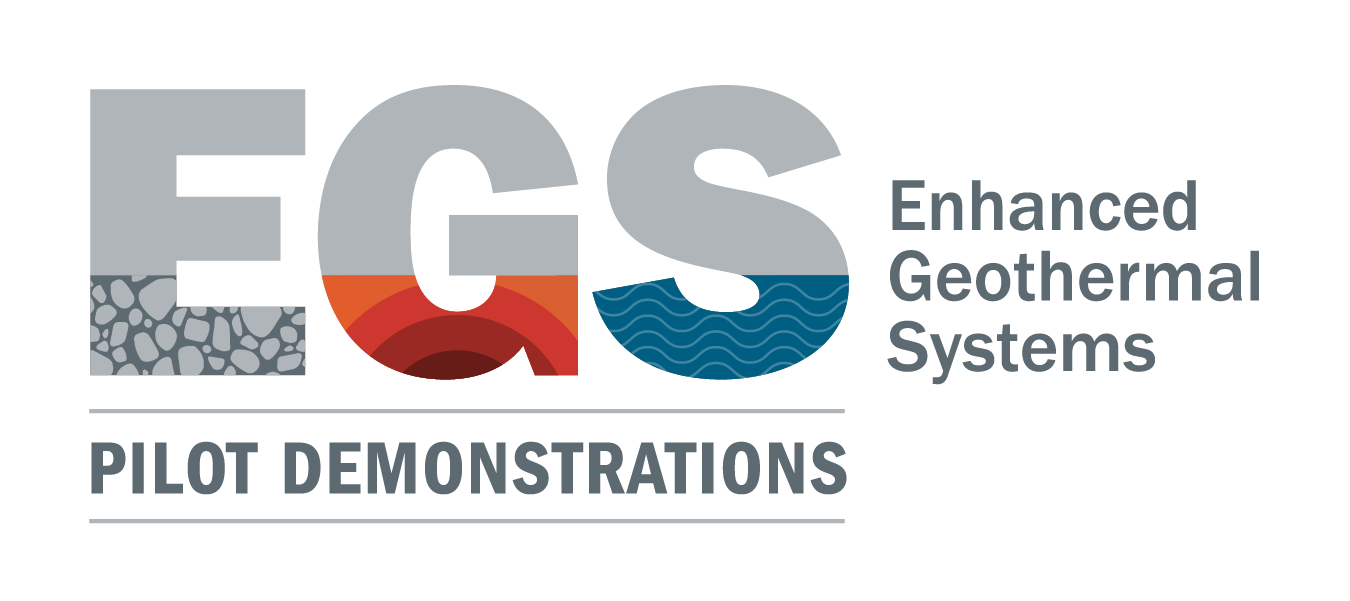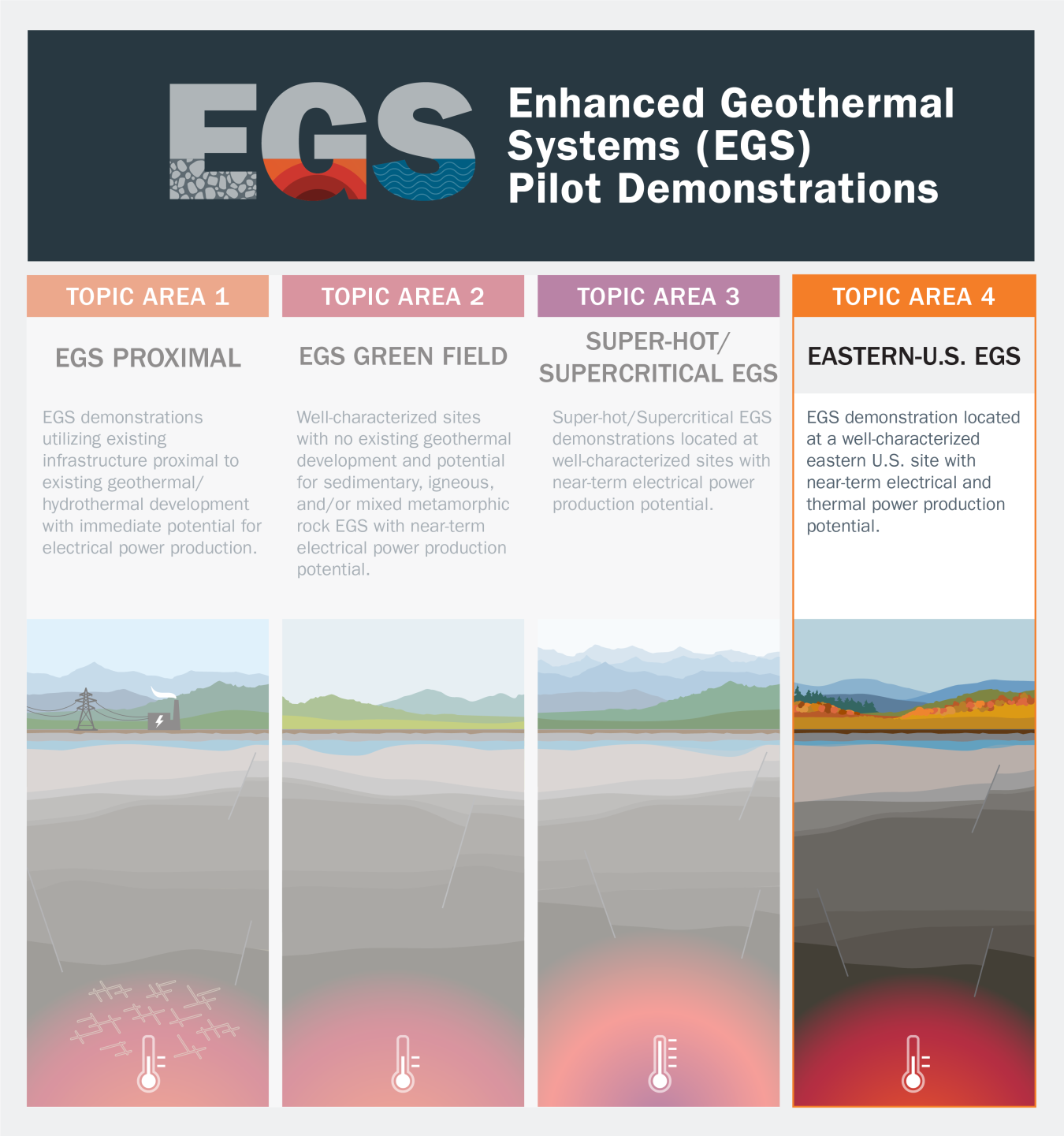Second-Round FOA number: DE-FOA-0002826
Second-Round FOA Amount: $14.2 million
Letters of Intent Due: July 18, 2024
Full Applications Due: September 25, 2024
The U.S. Department of Energy (DOE) has opened the second-round funding opportunity for enhanced geothermal systems (EGS) demonstrations. The Infrastructure Investment and Jobs Act authorizes DOE to support competitively selected pilot projects that collectively demonstrate EGS in different geologic settings, using a variety of development techniques and well orientations.
The work in projects selected under this second-round funding opportunity, along with those selected in the first-round funding opportunity, will advance EGS towards DOE's ambitious Enhanced Geothermal Shot™ Analysis and GeoVision analysis goals, and help spur further use of geothermal as a critical source of firm, flexible energy: 90 gigawatts of domestic electricity-generating capacity by 2050—enough to power the equivalent of more than 65 million American homes.
View the Teaming Partner List for information on how applicants formed a partnership to apply.
Objective
The economic viability of EGS depends on developing and improving technologies and understanding of the subsurface, including geologic qualities, permeability, and other attributes.
By developing EGS pilot demonstrations in a variety of geologic formations and subsurface conditions, projects selected under this opportunity will act as:
- Models, proving reliability and performance, and ultimately de-risking the suites of technologies required to develop and sustain EGS reservoirs
- Experiments from which to learn (learn-by-doing), using the upscaled opportunity to identify new problems that are not apparent at smaller, lab-based scales
- Opportunities to test hypotheses and validate design approaches for the geological conditions in which projects are located and extend those approaches to broader EGS development
- Opportunities for collaboration, such that best practices can be established and general operational processes can be standardized and improved
- Opportunities to begin connecting with consumers and off-takers to understand their needs and define the market, and to take those factors into account in design.
These pilot demonstration activities will advance EGS and other next-generation geothermal technologies. GTO’s strategic goals for this work are derived from the Enhanced Geothermal Shot™ Analysis, the GeoVision analysis, and GTO’s Multi-Year Program Plan (MYPP).
Topic Area
A key component of this initiative is to demonstrate EGS in a variety of geographic locations, geologic formations, and subsurface conditions, under four Topic Areas as denoted in the graphic. The currently open FOA seeks projects in Topic Area 4 only: demonstrating EGS at a well-characterized site in the eastern United States with potential for near-term electricity or thermal power production.
EGS demonstrations utilizing existing infrastructure proximal to existing geothermal/hydrothermal development with immediate potential for electrical power production.
EGS Proximal demonstrations will show that the use of EGS stimulation methods can transform low permeability or underproductive wells in or near existing hydrothermal fields into productive, economically beneficial assets for geothermal developers, with the goal of sustainably increasing the output of the existing reservoirs by at least 5 megawatts (MW) per site/well.
Sites with no existing geothermal development and potential for sedimentary, igneous and/or mixed metamorphic rock EGS with near-term electrical power production potential.
EGS Green Field demonstrations will target low-permeability geothermal anomalies with the potential for power production, where no current geothermal development exists. Selected projects will continue to hone understanding of what is required, especially with respect to zonal isolation and stimulation, to scale up EGS and ensure its viability throughout the United States.
Super-hot/Supercritical EGS demonstrations located at well-characterized sites with existing well(s) in place and near-term electrical power production potential.
Super-hot/Supercritical demonstrations will target low-permeability, super-hot/supercritical EGS resources (>375°C) with the potential for power production. Selected projects will be required to both improve understanding of the mechanisms controlling fracture generation and sustainability in superhot environments, and elucidate the relationships between reservoir permeability, fluid chemistry, temperature, and pressure.
EGS stimulation demonstration located at a well-characterized eastern U.S. site, with existing well(s) in place and near-term electrical power and heat production potential.
Eastern U.S. demonstrations will target low-permeability, high-temperature geothermal anomalies in the eastern United States with the potential for generation of electrical power and heat production as a cascaded resource. Selected projects will hone understanding of what is required to demonstrate the viability of EGS in the terrains of the eastern United States, especially with respect to stimulation technology/methodologies.
Key Dates (Subject to Change)
| FOA Second-Round Issue Date: | June 25, 2024 |
| Informational Webinar: | June 26, 2024, 1:00 p.m. ET |
| Submission Deadline for Letter of Intent: | July 18, 2024, 5:00 p.m. ET |
| Submission Deadline for Second-Round Full Applications: | September 25, 2024, 5:00 p.m. ET |
| Expected Date for Second-Round Selection Notifications: | Early 2025 |
| Expected Timeframe for Second-Round Award Negotiations: | Mid 2025 |
Additional Information
- Read about the Teaming Partner List on forming applicant partnerships.
- Sign up for GTO email notifications and subscribe to our monthly Drill Down newsletter to stay current with the latest GTO news and funding opportunities.
- Sign up for the Office of Energy Efficiency and Renewable Energy (EERE) funding emails and EERE news and the Weekly Jolt newsletter to get notified of new EERE funding opportunities and stay up to date on EERE news.



